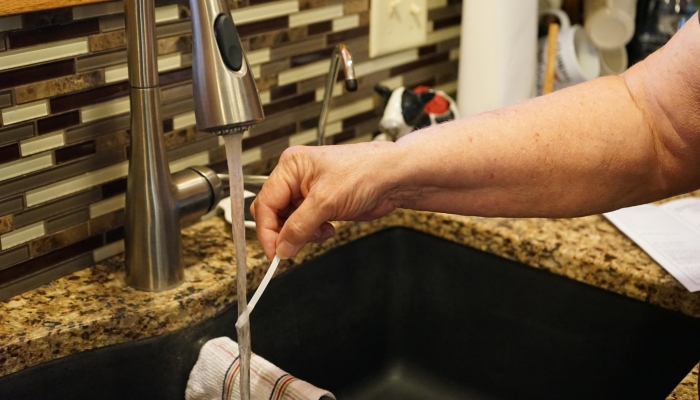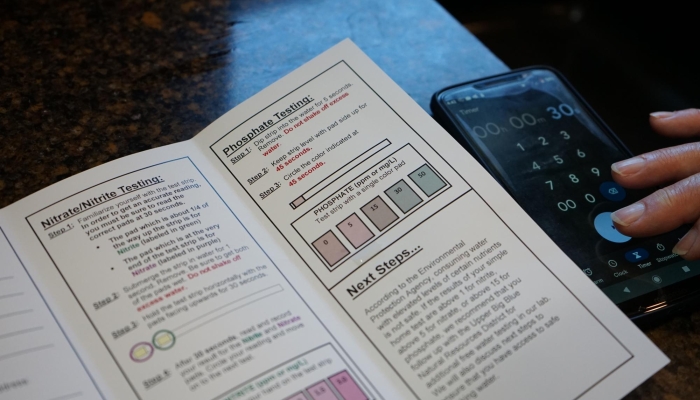Free water quality test kits offered to rural residents
Do you know what’s in your water?
If your home’s water comes from a private well in Nebraska, you may have elevated levels of common nutrients found in agricultural fertilizers. Consuming water with elevated levels of nitrate-nitrogen can have significant health risks, especially for younger people. Annual testing of your water is an important way to protect the health of everyone in your home—and a new test kit now available through the Upper Big Blue Natural Resources District makes that even easier to do.
###
For rural York County resident Ronda Rich, the results of a recent at home water test were eye opening. A board member for the Upper Big Blue Natural Resources District, Rich had learned about a home-test for common agricultural contaminants that was offered by the University of Nebraska Lincoln as part of a citizen science project on water quality. She requested a kit and recorded the levels of nitrate, nitrite, and phosphorus in her home’s wells. Then she repeated the test at a nearby neighbor’s house.
The results were startling.
While the water at Rich’s house was in the safe range for these contaminants, the neighbor’s water a quarter mile down the road was well beyond the maximum contamination level recommended by the Environmental Protection Agency. She was shocked to find that the results could be so different when the properties were so close together. Even on her own property, the house well (which pulled water from a deeper source) provided water with far less contaminant load than the well she uses to water her lawn and garden, though the wells are close together. Well construction details including depth can make a big difference in the quality of water they provide.
The results galvanized Rich into action. Now she’s telling everyone—if you live in a rural area and your water comes from a private well, get it tested every year. “Just because your neighbor doesn’t have a nitrate problem, doesn’t mean that you don’t,” she said.
While free water testing has long been available at the Upper Big Blue NRD office building in York, Rich feared that many who needed to test their water were not doing it because it was difficult to bring it in to the office during business hours. For those that don’t live close by, don’t have access to transportation, or work during the hours when the NRD would be open, Rich wanted to be sure that there was another option available.
 Thanks to a partnership with the University of Nebraska Lincoln, the Upper Big Blue NRD can now mail simplified at-home test kits to district residents for free. To request a kit, call (402) 362-6601 or email info@upperbigblue.org with your home mailing address. The at-home kits are not as sensitive as having a sample tested in the lab, but they do provide a simple way to determine if additional testing is required to identify what further steps need to be taken to improve drinking water quality, such as installing a reverse osmosis filter.
Thanks to a partnership with the University of Nebraska Lincoln, the Upper Big Blue NRD can now mail simplified at-home test kits to district residents for free. To request a kit, call (402) 362-6601 or email info@upperbigblue.org with your home mailing address. The at-home kits are not as sensitive as having a sample tested in the lab, but they do provide a simple way to determine if additional testing is required to identify what further steps need to be taken to improve drinking water quality, such as installing a reverse osmosis filter.
“One of my main concerns as a board member is water quality and making sure that people have safe drinking water,” said Rich. “This is a fast and easy test to do at home and it will give you a fairly close idea to whether you have a nitrate problem or not…There are so many negative effects of drinking high nitrate water that you need to know what you’re drinking.” Rich recalled a family who used to live in the neighborhood whose young son died of cancer. Might his condition have been related to high nitrates in the well? Rich can’t say for sure, but she has her suspicions.
Studies have found that various negative health outcomes are associated with high concentrations of nitrate in drinking water. Nebraska has one of the highest rates of some pediatric cancers, which may be linked to nitrates in water. The most vulnerable populations when it comes to the dangers of nitrates in water are young infants (less than six months old), pregnant women and children in-utero, and people with oxygen transport or delivery conditions like anemia, cardiovascular disease, lung disease, and sepsis.
Numerous scientific studies have looked at the relationship of nitrate in drinking water on human health and linked high concentrations of nitrate in drinking water to adverse health outcomes. The strongest links are for methemoglobinemia, colorectal cancer, thyroid disease, and neural tube defects (birth defects of spine, brain, and spinal cord). It is also linked to increased heart rate, nausea, headaches, and abdominal cramps; cancers including pediatric brain cancer, kidney cancer, bladder cancer, and non-Hodgkin’s lymphoma. Other studies are also examining a possible link between nitrates and Alzheimer’s, diabetes, and Parkinson’s disease. (See video at bottom of page for details)
The EPA guideline for safe drinking water is less than 10 parts per million of nitrate. Municipalities are required by law to provide water that meets the EPA criteria, but for the many Nebraskans whose water comes from a private source, the responsibility for the quality of the water is the responsibility of the consumer.
According to the Nebraska Water Center, nitrogen is a valuable fertilizer source that keeps Nebraska growing abundant crops. Nitrogen that does not get used by the crop may end up in Nebraska’s streams, lakes and groundwater. Nitrate is the most common form of nitrogen found in water. Though many farmers have implemented changes to reduce the likelihood of contamination over the years, in the Upper Big Blue NRD there has been a steady increase in nitrogen concentration in groundwater samples across the district. While there have been decreases or plateaus in some areas of the district, there has been an overall increase of 54 percent across the district in the last 20 years. Half of the district is now in a Phase II or Phase III management zone, meaning additional management is required due to the increased level of nitrogen in the groundwater.
As previously mentioned, the at-home water test kits began with a citizen science project on water quality from the Department of Civil and Environmental Engineering at the University of Nebraska-Lincoln. The ongoing project at UNL seeks volunteers from across the state to test their water and report their findings. The data dashboard charts water quality along watersheds in the state. According to the website, “the goal of our program is to measure levels of plant nutrients present in well water, rivers and streams within Nebraska. The reason we are testing private wells on farms is to give an opportunity to farm families to improve their health by identifying potential contamination of drinking water supplies by excess nutrients.”
Performing the test takes a matter of minutes. Results can be recorded on a sheet included in the kit and mailed back to the university or entered directly on an online form. A team then enters the results in an anonymized database that is accessible to the public. No personally identifying information, such as well address, will be available on the public facing dashboard.
It’s important to test drinking water annually, Rich reminds district residents, as results can change from year to year. If the results of the at-home water quality test reveal greater than 5 parts per million, the NRD staff recommends following up for a lab test for verification and to determine next steps to ensure safe drinking water. To bring in a sample to the NRD for nitrate testing, no special bottle is required. Any clean container will do. If you would like the water tested for bacteria (also recommended to test this annually), the water must be in a sterile container, which may be picked up from the NRD office. The water must be kept cool and delivered to the NRD within 24 hours for best testing results.


